For the last twenty five years I have been training in Itotsu ryu Kobudo. In this page I will look at the five main Kobudo weapons-the Nunchaku, the Bo, the Sai, the Tonfa, and the kama.
Nunchaku
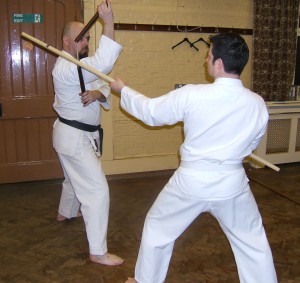
Deflecting with the nunchaku!
The style that I do is traditional Itotsu ryu which bears little resemblance to the flash‘Bruce Lee’ style of ‘showy’ nunchaku which is often seen nowadays at demo’s and on television. In traditional nunchaku there is no bouncing the weapon off your private parts or passing the weapon between your legs! I have seen demonstrations where exponents hang the weapon round their necks-an instant invitation to strangulation; and have witnessed people throw the weapon high into the air. It is hard to imagine a situation where an Okinawan farmer would, when facing down some armed brigands, throw a perfectly good weapon up into the air! There is a place for this type of training, but it should not be confused with the martial art from which it developed.
The nunchaku developed in Okinawa and there are a number of explanations for their development. The most common one is that they developed from the longer ‘rice-flails’ common throughout South East Asia, and that the fighting version of the flail would be hung along side the innocent flails. The second is that they developed from the wooden clappers used in schools, agriculture, and martial arts. The third is that they were hung alongside the wooden blocks used as a primitive form of fire alarm. The final explanation is that they developed from the wooden horse bridal found in Okinawa and Japan.
All of these are plausible explanations, and all have the common thread of two
pieces of wood tied with cord being concealed amongst innocent farming
implements.
Traditional nunchaku should be joined with strong cord and be fourteen inches long. There are a number of schools which used chained nunchaku, but they are in the minority for a number of reasons. Iron ore was not widely available for the construction of chains two hundred years ago on Okinawa. For the nunchaku to be hung alongside farming implements chain would have stood out. Cord is much safer to train with as it generally frays through gradually so the student gets some
warning prior to it snapping, whereas chain can suddenly break-leading to
accidents. Many of the Okinawan weapons were used against brigands and the
like, but historically they were also used against sword armed samurai. If you
imagine a swordsman standing in front of you it becomes clear that in order for
you to strike his right hand you need to be using long fourteen inch nunchaku
gripped at the end. I often see non traditionalists gripping the nunchaku near
the centre for speed twirling, but in traditional styles the weapon is always
gripped at the end and usually with the pinky at the base. The cord should be
tied at the side and there should be adequate length to circle a bo(rokushakubo
or staff). If the cord is too short when you trap a bo the end of the nunchaku
can break due to the pressure
Bo
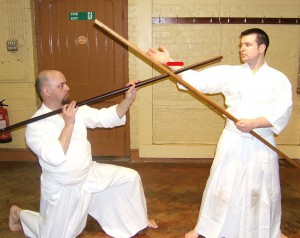
Strike the wrist!
In every culture the six foot staff has always been used as a weapon. The English quarterstaff was made famous in ‘Robin Hood’ films, and is still practiced today in a few scattered training halls. In China long staffs of many varieties are still taught. In Japan Koryu styles including Katori Shinto ryu still practice with staff of various lengths. And in Okinawa three foot, six foot, and eight foot staff are still wielded in many of the islands Kobudo dojo. The rokushakubo, literally six-foot-staff can be found in the style of Itotsu-ryu kobudo, which takes its name from the founder Ankoh Itotsu(sometimes pronounced Itosu). This style uses both the tapered(kon), and the untapered version of the bo. The honbu dojo is in Tokyo, Japan. The training in Okinawan styles of bojutsu differs somewhat from Japanese in as
much as Japanese styles tend to use Bo against Sword for the main body of their
pair-form training, whilst Okinawan stylists usually practice against the rest
of the kobudo arsenal including nunchaku, sai, tonfa, and kama.
Itotsu ryu kobudo is typified by training classes which follow typical
Japanese lines of the class being split into Kihon, kata( popular kata are ‘Shushinokon’ and ‘Seisokunokon’), and pair-forms (partner work). Kihon training introduces the student to the various strikes and blocks. This usually begins with solitary repetition of the movements with a medium weight bo. Sometimes a heavier bo or tetsu-bo are introduced to strengthen the muscles the student needs to manipulate the bo. Next the student practices the various blocks and strikes against a parter also armed with a bo.
Padded or graphite flashing weapons are not used. The initial training is
repetitive and often results in numerous blisters on the hands. This type of
training results in a lot of bo snapping when contact is a little heavy. This
is especially true when the students are trying to build up their strength-but
before they have learned to control it. It is important to get to know the
sound your bo makes during clashing exercises so that you can hear for a bo
with a hairline crack. This difference in sound may give you some warning prior
to your bo breaking. Before each lesson the bo should be tested by holding it
diagonally up from the ground and pushing down on the middle of the bo with
your foot. This type of test will also help give you some warning if your bo is
about to break.
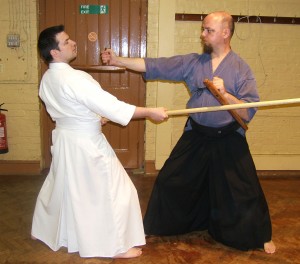
tonfa vs bo!
The beginner starts by holding the bo in a relaxed stance with the weapon split in to three parts equally, moving up and down the hall either by himself or with a partner. Initially little thought is given to the hips or grip, but eventually the student learns to use his hips to generate a whip like power. This is aided by coordinating both hands when striking. For example, the downwards strike is aided by pulling through with your rear hand as the front hand punches out. A relaxed grip can also help the strike, where focus is much more important than muscular strength. Power can come from much more than strength, but initially the training is gruelling and unrelenting in an effort to build up the student. Next he must learn how to manipulate the bo. This can be hard as the student now has to move the weapon so that the length can be utilised to the most advantage. The benefit of using the bo is that it out reaches most other weapons, but not if you hold it in ‘thirds’. The key to good kihon with the rokushakubo is to keep the bo moving- nearly always lengthening the striking part of the bo. It is important to remember that a Katana is longer than a third of a bo, but way shorter than three quarters of a bo ! In clashing exercises the student is initially improving his timing, distancing, coordination, and understanding of strategy. However it is important to remember that behind every clash of weapons there is a strike. Hidden behind every block there is a method of either striking, or disarming your opponent. Look below the surface of every clash to see what you are really being shown, and what you may really are being taught.
The same holds true for the pair-form training of kobudo, where every clash hides another meaning. Like with Japanese koryu training, patterns are layered so that each student will get different things from each set, depending on his level of understanding. Pair-form training initially teaches coordination, but this is rapidly replaced me an understanding of initiative. Initially it will be unclear to an onlooker who is attacking, and who is defending. However the student will learn not to anticipate the attack, and eventually will appear to respond to a free attack.
This however takes some time, and much repetition. The student gradually learns
how to manipulate the bo and will eventually use it for locks and takedowns, as
well as strikes and blocks The kata in Itotsu ryu kobudo are traditional forms. They are not flash, and are executed with traditional weapons, and without music! The kata teach strategies, timing, coordination and focus. There are many bo kata in existence, but the important thing is to learn to do one well-not know 20 superficially!
Sai
The sai are amongst kobudos’ most versatile weapons. They do not only possess four striking areas and an independent blocking surface, but also have a trapping area. This means that the sai can be used to block, strike, and trap. Significantly this is true whither the weapon is held with the blade along the arm, as well as when the blade is in the extended position. This article will look briefly at the sai from the point of view of Itotsu ryu sai-jutsu.

sai vs bo!
The sai were most probably imported into Okinawa via the Fukien trade route as iron ore was not found on the Ryukyu Islands originally. There are many examples of sai like weapons in China and Indonesia including the Tjabang. It is likely that the Sai originate here rather than in Japan-the old idea that the sai developed from the Japanese jutte is now widely rejected. The idea that the sai developed from a farming implement is also unlikely. The most likely explanation for its origin is that it was imported via Sailors or martial arts teacher via China, and was then perhaps hidden alongside farming implements for security. Other sai-like weapons developed in Okinawa including the Nunte(sai where one tang faces rearwards), the nunte-bo, and the guardless sai.
Sai come in a variety of lengths and weights in Japan, however in the West we tend to see them as either 19.5 inches long or 21.5 inches long. When selecting a pair be sure that the point projects past your elbow, and that the joint between tang and guards is a large one. Some companies sell cheap light sai-but these are not suitable for kobudo training.
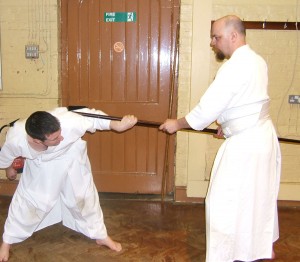
A block is also a lock!
Training with sai is broken into three parts-as with most traditional martial arts. Initially the student learns the kihon-this serves to build up the arms and improve the basic strikes and blocks. Pair-form sparring comes next which is usually various clashing exercises, followed by more elaborate sparring drills. Note that in traditional kobudo plastic weapons and free sparring are virtually extant. Next comes kata training(a popular kata is ‘Tsukenshitahakunosai’) which serves to teach various combinations, strategies etc.
Tonfa
The Okinawan tonfa are perhaps the most familiar of the weapons of the Ryukyu islands to us due to our police force carrying the similar side handled batton. However they both look different, and are used differently. The side handled battons are available to UK police forces in a number of designs and lengths both extended and extendable. Common versions include the Monadnock style PR22 and PR24 which are carried extended and singly. Tonfa were traditionally used in pairs allowing the practitioner to make use of the independent blocking surface of one weapon whilst using the other to damage the opponent. Unfortunately it takes many hours of practice to wield the tonfa effectively, so police forces, with a
limited training budget only learn to manipulate the weapon basically. It is
for this reason that the versatile weapon is often used as a simple clubbing
device. This article will introduce you to the tonfa but will not cover drills,
pairforms, or kata.
When choosing tonfa try to find weapons which are pegged and stick out beyond your elbow. The length allows for effective blocking and elbow striking. The cross pegging is not found on cheap tonfa which tend to fall apart when used against bo in sparring exercises! Tonfa are priced between £10 and £100 and it is true to say that you get what you pay for!
It is generally thought that the weapons developed from the mill handles used for the grinding of flour in agriculture. As with the other Okinawan weapons, the real weapon could then be hidden alongside the farming implements.
Tonfa (sometimes pronounced tuifa) can be held either retracted or extended and it is necessary to be able to rotate the weapon between these two positions quickly. The retracted position allows a powerfull punch to be delivered with the short end, as well as giving one a strong reinforced blocking surface. While extended a greater range can be covered using either the ends for thrusting strikes, or the sides for whirling strikes. During basic training blocks and strikes are practiced, including the figure of eight whirling strikes often associated with other weapons. It is
interesting to note that the blisters and callouses gained whilst using the tonfa are in slightly different places to those experienced from the other Okinawan weapons!
After basic training students begin to work on kata which are long sequences designed to, amongst other things, let the student practice his various waza-a common tonfa kata in Itotsuryu is ‘Tonfa no Hamahiga’. Pairforms, or pre arranged sparring comes next where exponents practice together.
Kama
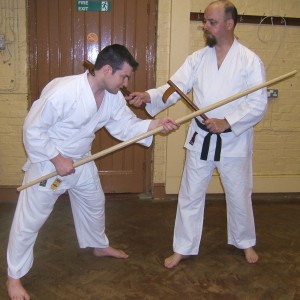
kama action!
The Kama or ni-cho-kama(sometimes spelled kamma or gama) are an interesting weapon from Ryukyu Kobudos warrior arsenal. Used in pairs theyare found throughout South East Asia in a number of guises. The fighting kama could easily be hidden alongside the brittle farming implements and were therefore an excellent choice for a weapon. In Japan interesting kama type weapons are found amongst a number of ryuha including the Kusarigama which esists in a number of forms. The kama themselves have a sharp steel blade which is attached securely to an oak or kashiwa handle. Sometimes the blade has an offset tang, but usually it is attached by two counter sunk bolts. The modern farming implements have a very weak join and should not be used for kobudo practice-not even kata. The focus of even strikes against the air can dislodge the blades from these cheap farming implements. I remember seeing them for sale in Japan for about £4 but being warned off from buying them. It is interesting to note that these cheap, weak weapons are now offered for sale on popular auction sites as’ kama for martial arts practice’! For training purposes wooden cross pinned kama can be purchased for around £30-60. This sounds expensive-but the cheap £7 kama being marketed in the UK currently break with only minimal contact with Rokushakubo. A cross between wooden training kama and real kama are the wooden handled ones which have a thick blunt blade-these are sturdy for training but should not be used by beginners. I have a number of sets of kama which I obtained about 20 years ago which have lasted well-but the current trend by importers to avoid Japanese weapons in favour of cheaper Chinese ones means that it can be hard to get inexpensive quality weapons. Prior to training with the kama always inspect the joint between the handle and the blade. The versatility of the kama is not at first obvious-it seems only to have a cutting blade. However the
handles can be used to block and deflect the opponents weapon when the kama are held extended. When the weapon is held with the handles down the forearms it can still be used to block and cut the enemy. Many of the weapons most effective moves involve ripping the opponents weapon away with an ensnaring whip-like action. It is important to note that the kama have no independent blocking surface where the hands are fully protected. This means that they are less safe to block with than the tonfa or sai which both possess a protected blocking surface. Of course-when armed with two weapons this might not always be a problem!
Kama training progresses like all other kobudo training starting with repetitive
kihon exercises, followed by more complex combination drills. Next these kihon
and drills are practiced with a partner armed with bo. Pairform or pre arranged
sparring comes next. The exercises start as simple block-counter exercises
culminating in complex sequences which test and train the students distancing
and timing. Kata training comes last, where the student must coordinate his
body and mind with the weapon. In Itotsu ryu ‘Tozan no kama’ is commonly taught. The kama are an interesting kobudo weapon which combine cutting blades with the blocking and redirection offered by weapons like the tonfa.
I hope that this article has helped your understanding of these traditional Ryukyu Kobudo weapons!







Yes-they are very good-I have used him many times-I even got tinbe/rochin from him. Regards, Chris.
Thanks in support of sharing such a nice thought, article is good, thats why i have read it completely